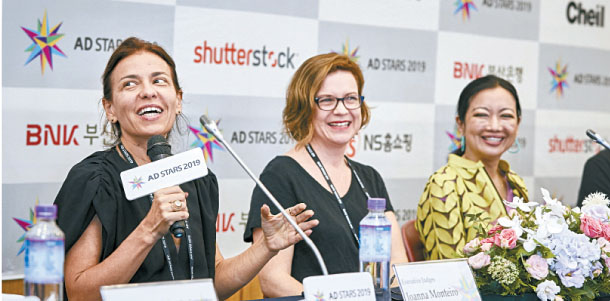Ad execs stress need for diversity

From left, FCB Brazil Chief Creative Officer (CCO) Joanna Monteiro, BBDO Atlanta CCO Robin Fitzgerald and Thailand-based GREYnJ United CCO Jureeporn Thaidumrong answer questions during a press conference at 2019 AD Stars on Thursday. [AD STARS ORGANIZING COMMITTEE]
Digital technology and social media is breaking down borders in the advertising industry. An ad campaign aired in one country can reach the other side of the globe in no time. This increases a necessity for more female leadership in the industry, said a handful of jurors at 2019 AD Stars.
Among five executive jurors at the annual advertising and marketing festival this year, three were top female executives from international advertising agencies. This is the largest figure in the annual event’s 12-year history. Last year, there was one.
BBDO Atlanta Chief Creative Officer (CCO) Robin Fitzgerald, Thailand-based GREYnJ United CCO Jureeporn Thaidumrong and FCB Brazil CCO Joanna Monteiro are among some of the first-generation female leaders in advertising industry.
“The world is changing on this gender issue and we are far away from the ideal,” said Monteiro, adding that women only make up 3 percent of the leadership in the advertising industry. “The industry should make a political decision to have more diversity, not just because brands nowadays need to do the right thing, but also because of economics.”
“Companies that have more diversity are actually more successful - in everything,” Fitzgerald added.
Monteiro emphasized that the voices of female leadership are important because campaigns today have to connect with all sorts of people.
“We have to talk with the consumers knowing them. You can’t only have men talking to women because they’ll do it in the wrong way,” she said. “If you don’t have [black creators] and you have 60 percent of black consumers - you’re doing the wrong thing. It’s fundamental to have diversity to talk to different people.”
On what “good creativity” looks like, Thaidumrong said that while creative ideas were about solving the problems of the brand, nowadays it was increasingly about touching on the problems of the world and people in general.
“Right now, as gender inequality and [diversity] are [being discussed], I find it at the moment we have an advantage of being a woman in the creative business,” she said.
But even in an environment where brands have to speak to diverse audiences, the leaders unanimously said that clients should not be afraid of taking a stance.
Monterio cited Nike as a good example. The sports brand is famous for its ad campaigns centered on female empowerment. And while it did lose money at one point, the company eventually saw better results in the long term, she said.
“From now on there will always be lovers and haters. Global campaigns sometimes want to reach everyone but end up reaching no one. They have no personality,” said Monteiro.
“Nowadays you stand for something, or you become invisible.”
BY SONG KYOUNG-SON [song.kyoungson@joongang.co.kr]










with the Korea JoongAng Daily
To write comments, please log in to one of the accounts.
Standards Board Policy (0/250자)